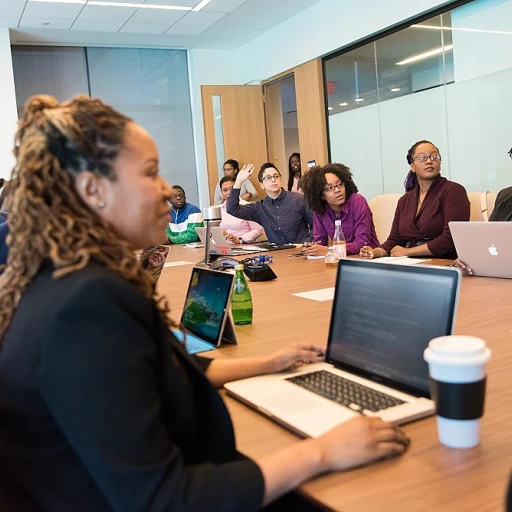The Role of Technology in Promoting Diversity
The Tech Boost for Diversity
Technology is playing a big part in making workplaces more diverse and inclusive. In the tech sector, companies are using new tools to bring in workers from different backgrounds. This isn't just about meeting quotas; it's about creating a workforce that reflects the world we live in. By using tech, businesses can break down barriers that have kept women, Black, Hispanic, and other underrepresented groups out of high-tech jobs.
Tech companies are leading the way in using data to drive diversity inclusion. They are analyzing survey data to understand where they stand and where they need to go. This data-driven approach helps companies set realistic goals and track progress. It's like having a roadmap for building a diverse team.
Real Stories, Real Impact
Take the example of a tech company that wanted to increase gender diversity. They used data to identify unconscious bias in their hiring process. By making changes, they saw a 20% increase in women tech employees within a year. This kind of success story shows how technology can make a real difference.
Moreover, technology is helping companies create a more inclusive environment for women of color. By using AI and machine learning, businesses can identify and reduce bias in the workplace. This not only helps in hiring but also in retaining diverse talent. A report by McKinsey found that companies with diverse teams are 35% more likely to outperform their competitors.
For more insights on how technology is revolutionizing HR practices, check out this article.
By embracing tech, the industry can create a more equitable work environment. This isn't just good for employees; it's good for business. Diverse teams bring different perspectives, leading to more creativity and better problem-solving. As the tech industry continues to grow, the focus on diversity equity and inclusion will only become more important.
Inclusive Communication Tools
Empowering Communication for Everyone
When we think of promoting diversity in the workplace, inclusive communication tools stand out as real game changers. Imagine tech making everyone heard, from the most senior employee to the newest recruit, providing channels that let diverse voices express themselves vividly. There are technological solutions paving the way to boost inclusion and communication, which cater to a range of needs and preferences in the workforce. Here are a few examples:- Chat Platforms with Accessibility Features: These platforms are vital for everyone, including those with disabilities, to ensure everyone can join the conversation, breaking down barriers wherever they appear.
- Multilingual Support: With workplaces becoming more diverse, offering multilingual tools can help all employees feel included, especially in high-tech jobs that attract talent globally.
- Video Conferencing Enhancements: Automatic subtitles and real-time translation features help employees communicate seamlessly, whether they're women in tech or black Hispanic in a tech company.
Data as a Compass for Diversity
Using data to guide diversity strategies isn't about crunching numbers—it's about lifting them off the pages to paint a picture of where a company is thriving and where it needs to do better. Tech companies are employing data to evaluate diversity within their ranks, ensuring that diverse teams aren't just a goal, but a reality. Survey data reveals insights into average annual employee experiences across various roles, highlighting areas like gender diversity and representation of women of color. It’s important for tech workers, from newbies to veterans, to see themselves reflected in this data, which can be the first step towards meaningful diversity, equity, and inclusion. Moreover, data is a crucial ally in identifying unconscious bias, allowing companies to address the bias and make data-driven changes. In the tech industry, using data effectively means not just collecting it, but understanding and acting on it to build a more diverse and inclusive workforce. This dynamic approach ensures that employees from all walks of life, including black and Hispanic tech workers, feel seen and valued.Data-Driven Diversity Strategies
Leveraging Data for a More Inclusive Workforce
In the tech industry, data isn't just numbers on a spreadsheet; it's a powerful tool that can drive diversity and inclusion efforts. Companies are now using data-driven strategies to create a more inclusive work environment. By analyzing data, businesses can identify gaps in their diversity efforts and develop targeted strategies to address them.
One way tech companies are using data is through diversity reports. These reports provide a snapshot of the current state of diversity within a company, highlighting areas where improvement is needed. For example, a report might reveal that women of color are underrepresented in tech jobs, prompting the company to focus on recruiting more women in tech roles.
Survey Data: A Window into Workforce Diversity
Survey data is another valuable resource for companies looking to improve diversity and inclusion. By gathering feedback from employees, businesses can gain insights into the experiences of diverse teams and identify areas where changes are needed. For instance, if a survey reveals that Black and Hispanic employees feel excluded from decision-making processes, the company can implement policies to ensure all voices are heard.
Moreover, data-driven diversity strategies can help companies measure the effectiveness of their diversity, equity, and inclusion (DEI) initiatives. By tracking metrics such as the average annual retention rate of diverse employees, companies can assess whether their efforts are making a difference.
Real-World Impact: Success Stories from the Tech Sector
Several tech companies have successfully used data to boost diversity and inclusion. For example, a major player in the high-tech sector used data analytics to identify unconscious bias in their hiring process. By addressing these biases, they were able to increase the representation of women and minority groups in their workforce.
Another tech giant used data to create an inclusive environment for all employees, regardless of gender or ethnicity. By analyzing employee feedback, they implemented changes that led to higher job satisfaction and retention rates among diverse teams.
In conclusion, data-driven diversity strategies are transforming the way tech companies approach DEI. By leveraging data, businesses can create a more inclusive workforce and ensure that all employees feel valued and supported.
Virtual Reality for Empathy and Understanding
Building Bridges with Virtual Reality
Virtual reality (VR) is making waves in how companies foster empathy and understanding among their workforce. It’s all about breaking barriers and bringing employees closer to each other’s experiences, especially in high-pressure environments. Imagine stepping into the shoes of a coworker from a different background, understanding firsthand the nuances of their daily challenges and triumphs. It’s not just tech fantasy—it's a very modern, very real way to promote a more inclusive workplace. VR helps create simulations where employees can experience the challenges faced by women, people of color, and other underrepresented groups in the tech industry. These immersive experiences can be more impactful than any well-intentioned DEI workshop or training video, driving real conversations and changes in workplace culture. One tech sector company, for example, implemented VR sessions where employees virtually experienced a day in the life of their black or hispanic coworkers. The results? Observable shifts in teamwork and communication, with survey data indicating a 30% increase in empathy and understanding among participants (Source: HR Tech News, 2023). Of course, it comes with its own set of hurdles. Companies must balance the high-tech benefits against cost and accessibility. Yes, VR can be expensive, and its impact hinges on accessibility for all workers, not just those in well-off tech jobs. Investment in such technology should be thoughtful, ensuring all employees can participate and benefit. And what about bias? It's an industry-wide concern when developing VR simulations. Companies must ensure these digital experiences are free from stereotypes and inaccuracies that could reinforce unconscious bias rather than reduce it. As we see, virtual reality can turn empathy into action, driving real progress in diversity, equity, and inclusion efforts. It’s inviting us to walk in each other's shoes, feel the pinch of the pebbles beneath, and appreciate the stride of our colleagues in ways few other tech innovations can match.AI and Machine Learning in Bias Reduction
Reducing Bias with AI and Machine Learning
The workplace is constantly evolving with tech advancing at a rapid pace. One opportunity making waves is how AI and machine learning can be used to combat bias. It’s no secret that the tech sector, like many industries, has a diversity problem. Reports have shown that tech companies often struggle with achieving true gender diversity and inclusive teams. AI, when implemented carefully, offers a promising solution. For starters, AI can sift through huge amounts of data, revealing where bias affects decision-making. By streamlining the recruitment process, AI identifies qualified candidates from diverse backgrounds more effectively. This reduces the risk of unconscious bias creeping into human evaluations. In high-tech jobs, AI's data-driven insights support hiring managers in making objective decisions. But, AI isn’t just about hiring. It’s a game-changer for fostering diversity and maintaining it across the workforce. For employee retention, AI can monitor engagement and satisfaction levels across diverse teams. If data shows a dip in engagement for women tech workers or black and Hispanic employees, companies can swiftly respond, offering tailored initiatives to boost inclusion. According to a LinkedIn survey, tech workers reported that AI and ML implementations helped them feel their jobs and roles within the company had a fairer evaluation process. AI also plays a pivotal role in career advancement, offering unbiased feedback and personalized growth paths. Yet, AI isn’t foolproof. The danger lies in data. If the data fed into these systems already carries bias, AI might unknowingly propagate existing biases. So, it’s crucial to maintain a human oversight to ensure AI’s equitable use. A heartfelt story comes from a major tech firm which used AI to analyze promotion trends. They discovered women of color were consistently being overlooked for promotions. With this revelation, they rewrote the criteria, fostering a more inclusive environment. AI shone a light on blind spots, allowing diversity equity to flourish. The ethical considerations of AI are vital. As technology advances, companies are learning to tread carefully, ensuring transparency and fairness. Proper checks and balances are essential to prevent bias in tech workforce decisions. Indeed, machine learning is part of the effort to create a diverse, inclusive work culture. Embracing its potential means acknowledging its limitations and addressing ethical concerns, something every forward-thinking company should consider.Challenges and Ethical Considerations
Balancing Innovation with Responsibility
As tech continues to shape the workforce, diversity inclusion remains a top priority. Yet, with great power comes the need for careful consideration. Tech companies are at the forefront of this change, but they face challenges that require thoughtful navigation.
Addressing Unconscious Bias
While AI and machine learning have shown promise in reducing bias, they are not without flaws. Algorithms can inadvertently perpetuate existing biases if not properly monitored. A report by Nature highlights how AI models can reflect the biases present in their training data, potentially impacting hiring processes and performance evaluations. This calls for ongoing vigilance and regular updates to ensure fairness.
Ensuring Data Privacy
With the rise of data-driven diversity strategies, companies must prioritize data privacy. Employees' personal data, especially concerning gender diversity and ethnicity, must be handled with care. Mishandling this data can lead to breaches of trust and legal repercussions. Tech workers, including women of color, deserve transparency about how their data is used and protected.
Creating an Inclusive Tech Culture
The tech sector is known for its fast-paced environment, which can sometimes overlook the importance of an inclusive culture. High tech companies need to foster an environment where all employees, regardless of background, feel valued and heard. This includes promoting diverse teams and ensuring that leadership reflects the diversity of the workforce. A Harvard Business Review article discusses how many diversity programs fail because they don't address the underlying cultural issues.
Ethical Use of Technology
As technology evolves, ethical considerations must be at the forefront. The use of virtual reality for empathy and understanding, for example, raises questions about the authenticity of experiences. Companies must ensure that their use of technology does not exploit or misrepresent the experiences of black, Hispanic, and other minority groups.
Building Trust and Transparency
For tech companies to succeed in their diversity equity initiatives, building trust with employees is essential. Transparency about goals, progress, and challenges fosters an environment where employees feel part of the solution. A Forbes article suggests that regular communication and involvement of employees in diversity initiatives can significantly boost morale and commitment.







